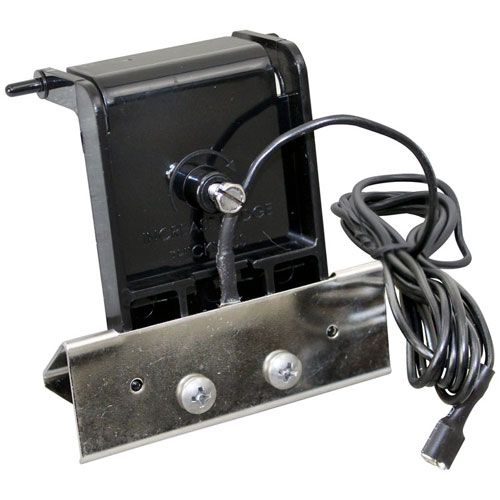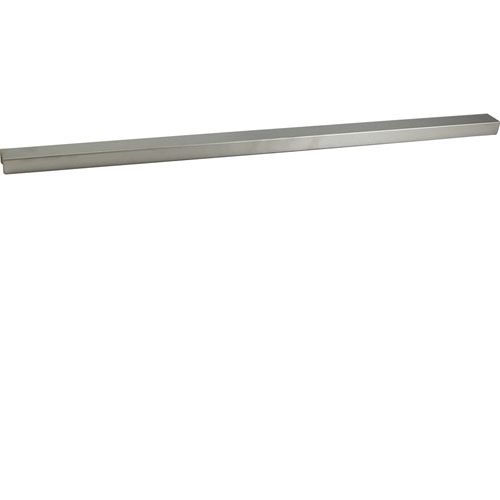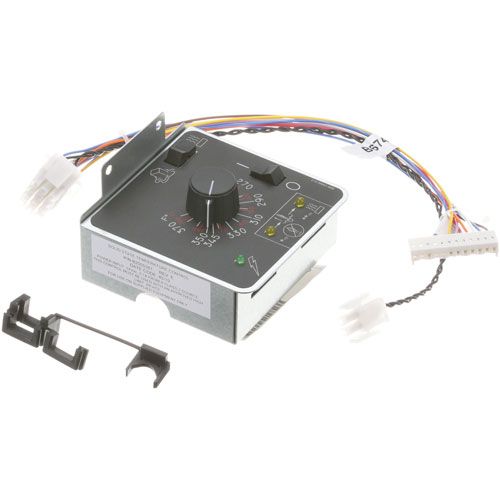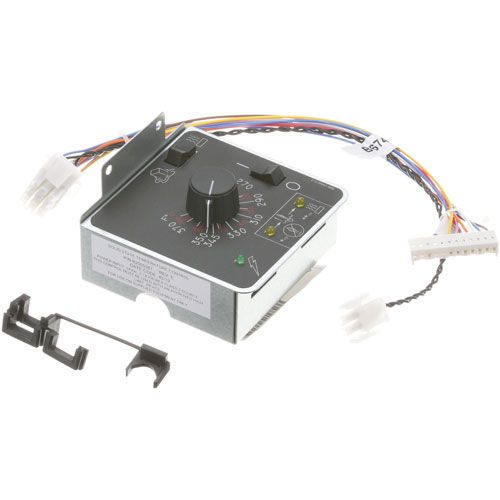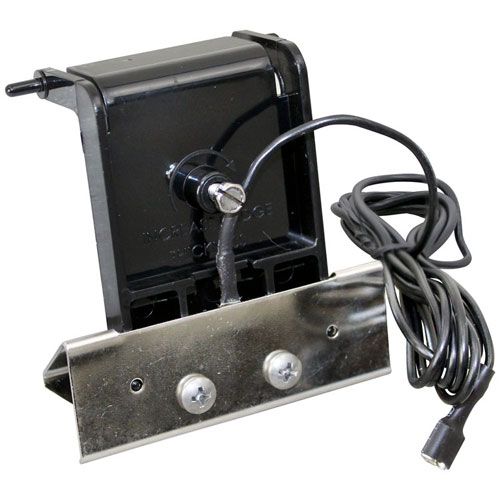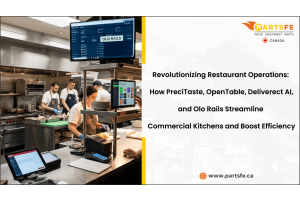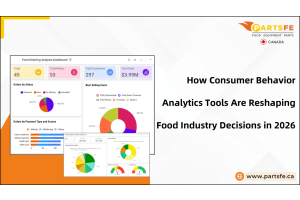Future Trends: What's Next for Restaurant Equipment?
In the realm of restaurant operations, having the appropriate equipment can significantly impact success. Effective restaurant equipment ensures smooth functioning, enhances food quality, expedites service, and improves the dining experience. Staying abreast of emerging equipment trends is crucial to remain competitive in an evolving industry. In recent years, two prominent trends have garnered attention in the United States: energy efficiency and contactless technology. Given the growing emphasis on sustainability and carbon footprint reduction, many restaurant owners prioritize energy-efficient cooking equipment. This includes incorporating LED lighting, high-efficiency refrigeration and freezing units, and induction cooktops. For those seeking commercial cooking appliance parts or looking to upgrade their kitchen, PartsFe stands out as the ideal destination.
Trend 1: Energy efficiency
Restaurants are increasingly emphasizing energy efficiency as a key strategy to trim costs and embrace environmental responsibility. Through the adoption of energy-efficient cooking appliances and systems, eateries aim not only to slash their energy expenses but also to play a part in mitigating their environmental footprint, thus fostering a more sustainable dining landscape.
What is energy-efficient equipment, and how does it benefit restaurants?
Energy-efficient equipment refers to appliances and systems designed to minimize energy usage and waste in various operations. In the context of restaurants, this typically includes kitchen appliances like refrigerators, dishwashers, ovens, and lighting fixtures engineered to consume less energy while maintaining performance standards.
For restaurants, integrating energy-efficient equipment offers several benefits. Firstly, it helps in cutting down operational costs by reducing energy bills. Secondly, it aligns with sustainable practices, enhancing the restaurant's reputation as environmentally conscious, which can attract eco-conscious customers. Moreover, these energy-efficient appliances often come with additional perks. They tend to operate quietly, generate less heat, and require minimal maintenance, contributing to smoother and more efficient kitchen operations. This reduced need for repairs and replacements can further save both time and money in the long term.
Benefits of investments in energy-efficient restaurant equipment
| Benefits | Description |
| Cost savings | Energy-efficient appliances consume less energy, leading to lower electricity bills over time. |
| Environmental sustainability | Transitioning to energy-efficient equipment reduces carbon footprint and environmental impact. |
| Enhanced brand image | Demonstrating a commitment to sustainability enhances a restaurant's brand image. |
| Improved operational efficiency | Energy-efficient equipment offers advanced features for better performance and efficiency. |
| Regulatory compliance and future-proofing | Investing in energy-efficient equipment ensures compliance with environmental regulations. |
How does energy-efficient equipment help restaurants cut operational costs?
Energy-efficient equipment presents several avenues for reducing restaurant operating costs:
- Decreased energy consumption: Opting for energy-efficient equipment means choosing models designed to consume less energy compared to traditional counterparts. This translates to lower energy bills, thereby reducing overall operating expenses. For example, investing in Energy Star-certified commercial kitchen appliances can yield savings of up to 30% on energy costs.
- Extended lifespan: Energy-efficient equipment is engineered for durability and superior performance, resulting in longer lifespans compared to conventional alternatives. With fewer breakdowns and replacements, restaurants save on repair and maintenance expenses, further trimming operating costs.
- Enhanced productivity: Energy-efficient appliances can streamline kitchen operations, boosting the productivity of restaurant staff. For instance, induction cookers and convection ovens heat up quickly, cook food evenly, and shorten cooking times. This efficiency allows kitchen staff to prepare meals more swiftly, ultimately reducing labor costs.
- Reduced heat output: Traditional kitchen equipment often generates excessive heat, leading to heightened cooling expenses as air conditioning systems work harder to maintain comfortable temperatures. Energy-efficient appliances produce less heat, alleviating the strain on cooling systems and cutting down on associated costs.
- Improved food quality: Energy-efficient kitchen equipment is designed to cook food more evenly, resulting in higher-quality dishes. By delivering consistently delicious meals, restaurants can attract more patrons, boost revenue, and ultimately lower overall operating costs.
How do you select the appropriate restaurant equipment for your business?
Choosing the right restaurant equipment for your business is crucial for efficiency and cost savings. Here are some tips on selecting energy-efficient equipment:
- Broilers: Look for units with timers or smart technologies to reduce idle time, potentially saving around $450 annually by cutting out just one hour of idle time per day. Newer broilers consume up to 25% less energy, including savings from idle time reduction and improved preheat times.
- Combination ovens: Invest in self-cleaning ovens that offer multiple cooking options like steam cooking and convection. By utilizing these settings efficiently, you can save up to $400 a year by minimizing idle time or turning it off when not in use.
- Convection ovens: Switching to energy-efficient convection ovens can save up to $360 annually on energy bills. Opt for models that cook quickly and evenly, reducing energy consumption, and ensuring proper maintenance to maximize efficiency.
- Fryers: Upgrade to newer models that automate processes to reduce energy usage, potentially saving $250 a year for every four hours of idle time eliminated. Investing in insulated fry pots with sealed tops can also minimize heat loss and save on energy costs.
- Griddles: Regular maintenance and calibration of griddles can save hundreds of dollars annually. Upgrading to energy-efficient models with adjustable parts can further reduce energy consumption, resulting in significant savings over time.
- Holding cabinets: Improve insulation and replace damaged parts to increase energy savings withholding cabinets. Simply turning it off when not in use overnight can save $500 a year, while investing in energy-efficient models can quadruple those savings.
- Ranges: Proper maintenance and calibration of burners can save energy costs, and covering ranges when not in use can further reduce energy consumption. Consider investing in induction ranges for improved efficiency and control.
- Steamers: Choose Energy Star-certified steamers that are connection-free to save over $2,000 annually. Look for models with timers to enhance energy efficiency and maximize savings.
Trend 2: Contactless technology
Contactless technology is becoming increasingly popular in the restaurant industry. This trend is driven by the need to reduce physical contact between customers and employees, particularly given the ongoing issues provided by the epidemic. Here is a breakdown of the essential characteristics of contactless technology that are worth mentioning.
What is contactless technology, and why is it growing so important in restaurants?
Contactless technology in restaurants refers to solutions that allow customers to interact with digital services without making physical contact. This includes features such as mobile ordering and payment, touchless menus, and contactless delivery. Following the COVID-19 outbreak, the role of contactless technology in eateries has grown. It is critical to reducing transmission hazards and protecting both customers and employees. Contactless payment systems assist eateries in adhering to social distancing requirements and preventing germ spread by minimizing physical contact. Furthermore, contactless technology improves operational efficiency and customer comfort, making it a valuable tool for restaurants as they face current difficulties and adapt to changing consumer demands.
How might contactless technology enable restaurants to improve their effectiveness and customer service?
Contactless technology has become a pivotal tool for enhancing efficiency and elevating customer satisfaction in the restaurant industry. By leveraging contactless solutions, restaurants can streamline operations and provide a safer, more convenient dining experience. Here are several ways in which contactless technology can achieve this:
- Effective order and payments: Contactless ordering and payment systems can be implemented by restaurants via mobile apps or QR codes. This eliminates the need for tangible menus and lowers the handling of currency or cards, lowering germ transmission risks.
- Decreased wait times: With contactless ordering and payment, consumers may make orders and pay bills quickly, eliminating the usual wait times associated with server interactions. This accelerates service and improves overall efficiency.
- Seamless reservation management: Contactless technology facilitates easy access to restaurant reservation systems, allowing customers to book tables in advance. This not only simplifies the booking process for patrons but also enables restaurants to optimize seating arrangements efficiently.
- Enhanced accuracy: Direct ordering through mobile apps or websites ensures accurate order placement, minimizing errors caused by miscommunication. Customers can select their preferences directly, leading to fewer mistakes in fulfilling orders.
- Personalization opportunities: Contactless solutions enable restaurants to gather valuable data on customers' dining habits and preferences. This data can be leveraged to offer personalized recommendations or exclusive offers, fostering stronger customer relationships.
- Improved hygiene standards: By reducing contact with high-touch surfaces such as menus and payment terminals, contactless technology promotes better hygiene practices within restaurants. This proactive approach to cleanliness enhances customer confidence in dining out.
What are the advantages of contactless billing and booking systems in restaurants?
| Advantages | Description |
| Enhanced hygiene and safety | Minimizes physical contact, crucial during the COVID-19 pandemic, promoting safety for customers and staff. |
| Improved operational efficiency | Simplifies ordering and payment procedures, reducing wait times and increasing table turnover. |
| Access to valuable customer insights | Enables restaurants to gather data on customer behavior and preferences for informed business decisions. |
| Meeting consumer expectations | Provides the convenience of digital transactions, meeting the expectations of modern consumers and staying competitive. |
The most recent advances in contactless technology for restaurants
Some additional innovations in contactless technology for restaurants include:
Contactless ordering and payment systems: Many restaurants are implementing mobile apps or websites that allow customers to browse menus, place orders, and pay without having to interact with staff directly. These systems often integrate with existing POS (Point of Sale) systems to streamline the ordering and payment process.
- Tabletop ordering devices: Some restaurants are deploying tabletop tablets or devices that allow customers to browse menus, place orders, and request assistance without the need for physical menus or staff interaction. These devices can also facilitate payment and feedback collection.
- Contactless delivery and pickup solutions: With the rise of delivery and takeout services, restaurants are investing in contactless delivery and pickup solutions. This may include designated pickup areas with QR code scanning for order retrieval, as well as delivery options that minimize direct contact between drivers and customers.
- Virtual waitlists and reservations: To manage capacity and minimize crowding, restaurants are leveraging virtual waitlist and reservation systems that allow customers to join queues or book tables remotely. These systems often notify customers via text or app notifications when their table is ready, reducing the need for physical waiting areas and interactions with host staff.
- Self-service kiosks: Similar to tabletop ordering devices, self-service kiosks enable customers to place orders and customize their meals without staff assistance. These kiosks can be placed at strategic locations within the restaurant or integrated into drive-thru lanes for convenient ordering and payment.
- Smart kitchen technologies: Behind the scenes, restaurants are adopting smart kitchen technologies that optimize workflow, monitor inventory, and automate repetitive tasks. These systems help reduce the need for staff to handle physical objects and streamline operations for increased efficiency and safety.
- Contactless feedback and communication: Restaurants are implementing digital feedback systems that allow customers to provide input on their dining experience without traditional comment cards or face-to-face interactions. These systems can also be used for communication between customers and staff, such as requesting refills or reporting issues.
Increase efficiency and production with modern kitchen automation
Advanced kitchen automation has altered the food industry by allowing chefs to maximize efficiency and output. Automated kitchen equipment uses cutting-edge technology to complete duties such as meal preparation, cooking, and cleanup. This streamlines the cooking process, allowing chefs to operate more efficiently and provide more results in less time.
The utilization of advanced kitchen automation not only saves time and boosts productivity but also ensures consistent quality across dishes. Furthermore, automation aids in curbing food waste and trimming labor expenses, making it a valuable investment for restaurants and food businesses striving to stay competitive.
As the restaurant industry evolves, factors such as energy efficiency and contactless payments will affect the future of restaurant equipment. Adopting such developments not only increases operational efficiency and cost savings but also provides consumers with a safe and convenient dining environment.
FAQs
What upcoming technologies are predicted to have an impact on restaurant equipment in the future?
Automation, artificial intelligence, the Internet of Things (IoT), and innovative materials are predicted to transform restaurant equipment, resulting in increased efficiency, productivity, and sustainability.
How will automation affect the landscape of restaurant equipment?
Automation is positioned to streamline restaurant operations by automating repetitive chores like meal preparation, cooking, and cleaning. This will result in better efficiency, lower labor costs, and more consistent food quality.
How will sustainability influence future restaurant equipment trends?
Sustainability will play a crucial role in shaping future restaurant equipment trends. Expect advances in energy efficiency, waste reduction, and eco-friendly materials to meet the growing need for sustainable practices in the food service business.
How will the Internet of Things (IoT) affect restaurant equipment?
IoT technology will enable interconnection across diverse restaurant equipment, allowing for remote monitoring, predictive maintenance, and data-driven insights to improve performance and reduce downtime.
What types of advanced materials are predicted to be used in future restaurant equipment?
Future restaurant equipment may include innovative materials like carbon fiber, graphene, and bio-based plastics, which provide increased durability, lightweight construction, and resistance to heat and corrosion.






